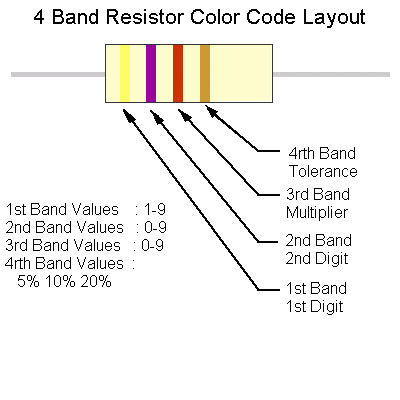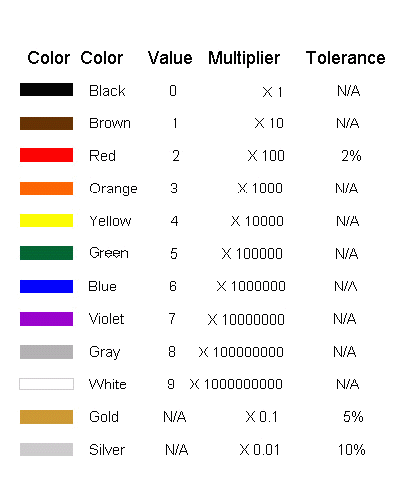
Resistor Color Code
Resistors are often marked with what is known as a resistor color code. Each band that surrounds the body of the resistor helps identify the value (in ohms), the tolerance (in percent), and in some cases the reliability rating. Most resistors are have a typical 5% - 10% tolerance value. As such normally only four (4) color bands are used. On the drawing below you will find how and where each band is located.

Notice in the previous
example how the resistors band tend to favor the one edge more closely
than the other. This offset is present on "most" resistors
and you can use this to help you identify which band is the first digit.
If you also notice that the right-most band is the tolerance band.
This band will often be silver or gold. Most significant is
the first band, it will always be some color other than black. In
one rare exception when you have a "Zero" (0) ohm resistor (a
solid wire or jumper), in this case only one black band will exist on the
the resistor. Other exceptions include body color which dependent
on the material the resistor is made up of, it may be brown, white, creme,
or light blue. You may also find that several colors appear to be
similar in color. Red and orange, brown and red, brown and violet,
gray and white are often the most difficult to discern. Near the
end of this document you will find a chart on the most common 5% to 10%
resistor values.
Shown below is the color chart for resistors. Color is used to represent a number, an in this way we are able to discern the value for each digit. In the previous example the first band was yellow, which stands for the number 4. On the second band is violet (some same purple) and it stands for the number 7. The third band is often the most difficult band to decode it represents the number of zeros or decimal places that you add to the the previous two numbers. In this case the band is red so you place two zero after the first two numbers (47 + two zeros = 4700). In this way we can describe a nearly infinite number of resistor values. For values less 10 ohms the color gold or silver will be placed in the third color band. When these colors appear we will move the decimal place the of the first two digits to the left. As an example if we are looking for a 4.7 Ohm resistor we should find a resistor with yellow (4), violet (7), gold ( X 0.1), silver or gold (10% or 5%). This becomes 47 X 0.1 or 4.7, it may take a litte practice but in this way we are able to specify resistors that are less than ten ohms.
| Shown on the right is the resistor color chart. Notice the colors and the various values that they may represent. For the tolerance notice that only few values are used. Also gold and silver are used primarily for the tolerance and resistor values that are less than (<) then 10 ohms. | 
|
Shown below is a list of the standard values that you may find. Note that these are "standard values". Parts kits, and suppliers often bundle values that are the "most" popular and as a result you may get more of one value than another. Typically decimal values (ie. 10, 100, 1000, 10000,..) are the most popular with values like 22XX 33XX 47XX 56XX following second. 75XX ohm, 82XX, and 91XX series values are available but not often included in bundled kits. You may ask why this happens, but notice that many of these may be approximated by combining other values. As an example 82 can be created using 47 and 33 ohms. This is not generally recomended but it can be done. Secondly designers and engineers often select values that are easy from them to work with. This leads to a selection process where designs often use a predominate value. More often than not this is because the designer can get a better price on 10000 resistors of one value than they can on 10 different values of 1000 pieces each.
| 1.0 | 2.2 | 3.3 | 4.7 | 5.6 | 6.8 | 7.5 | 8.2 | 9.1 | ||||||||
| 10 | 22 | 33 | 47 | 56 | 68 | 75 | 82 | 91 | ||||||||
| 10 | 22 | 33 | 47 | 56 | 68 | 75 | 82 | 91 | ||||||||
| 100 | 220 | 330 | 470 | 560 | 680 | 750 | 820 | 910 | ||||||||
| 1000 | 2200 | 3300 | 4700 | 5600 | 6800 | 7500 | 8200 | 9100 | ||||||||
| 10000 | 22000 | 33000 | 47000 | 56000 | 68000 | 75000 | 82000 | 91000 | ||||||||
| 100000 | 220000 | 330000 | 470000 | 560000 | 680000 | 750000 | 820000 | 910000 | ||||||||
Values over 1 Million Ohms (mega-ohms) are generally limited, primarily, because of their limited use. For those that are found, they generally follow a pattern as shown below. |
||||||||||||||||
| 1000000 | 2200000 | 3300000 | 4700000 | 5600000 | 6800000 | 7500000 | 8200000 | 9100000 | ||||||||
Normally the values of resistor values are not quoted using standard numerical notation (ie. 1000, 33000 ...). In electronics as with most technical fields very and large and small numbers are expressed using scientific notation. In the case of electronics scientific notation is combine with standard metric prefixes ( names that go ahead of the quantity that you are expressing). For resistors several common values are used.
| Value | Scientific Notation | Decimal Multiplier | Metric Prefix | Metric Letter | Example Value |
| 1000 | 1 X 10^3 | X 1000 | Kilo | K | 1 K |
| 100000 | 1 X 10^6 | X 1000000 | Mega | M | 1 M |
| .001 | 1 X 10^-3 | X .001 | milli | m | 1 m |
Shown below are some typical examples of how different resistor values may be specified. |
|||||
| 2200 | 2.2 X 10^3 | 2.2 X 1000 | Kilo | K | 2.2 K |
| 33000 | 33 X 10^3 | 33 X 1000 | Kilo | K | 33 K |
| 560000 | 560 X 10^3 | 560 X 1000 | Kilo | K | 560 K |
| 9100000 | 9.1 X 10^6 | 9.1 X 1000000 | Mega | M | 9.1 M |
| 75 | 75 X 10^1 | 75 X 1 | None | None | 75 |
| 0.47 | 47 X 10^-3 | 47 X .001 | milli | m | 47 m |
The easiest way to learn this system of numbering is to "just do it". This is truely a naming convention that requires practice and patience. My advice is to gather various values of resistors and throw them in a box together. Then using your color code chart, pull them out one at a time and decode their value. Or simply organize drawers with with the color code and its value. If you work at it, the colors will become second nature. Also as you learn to use this system you will find that their is a limited range of resistor number values (ie. 22,33,47,56 ..). In this, if you memorize the color values for these sequences, then you only need to decode the multiplier band (3rd band).

This Page has been accessed times since the last update on 6 September 1996